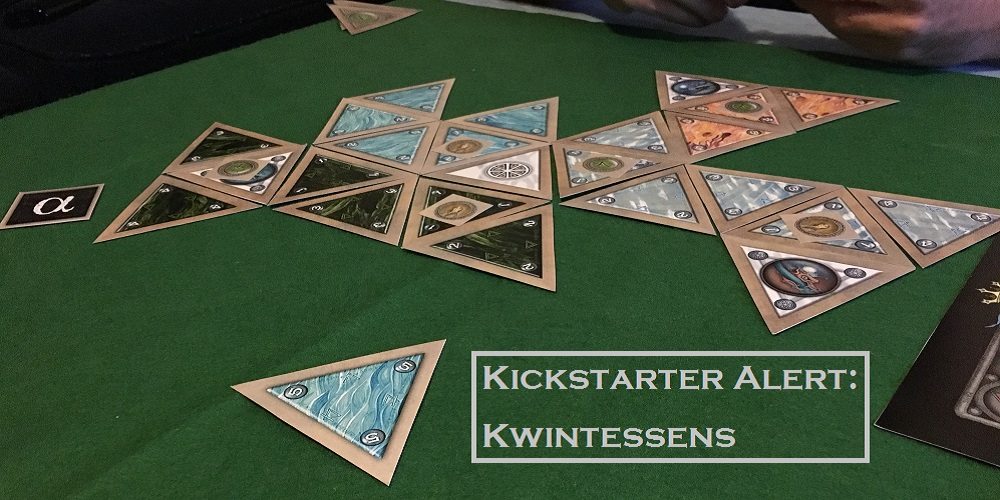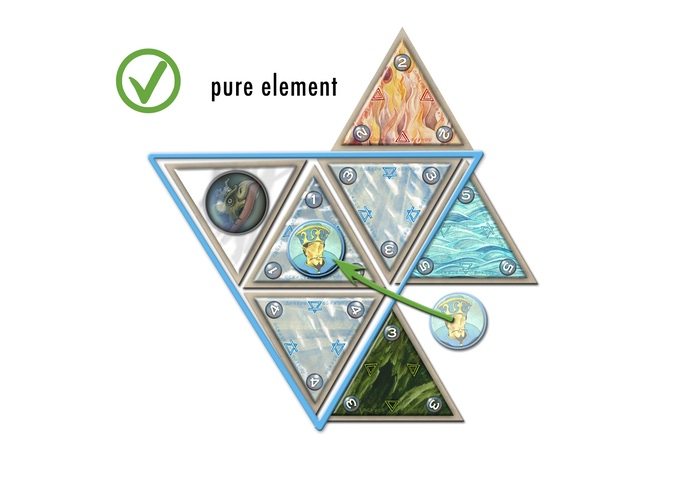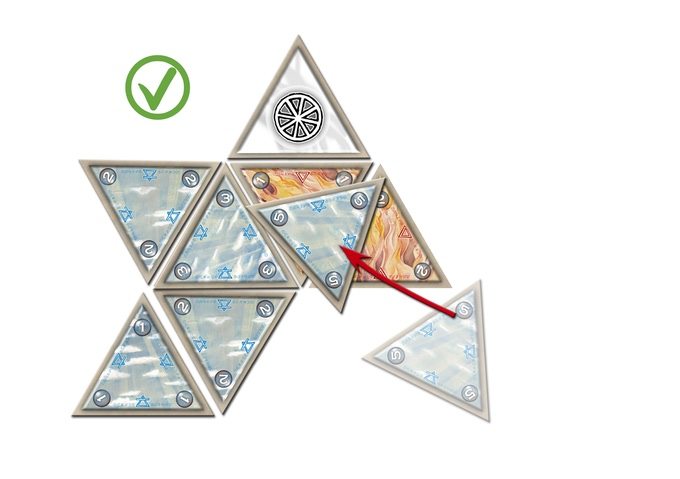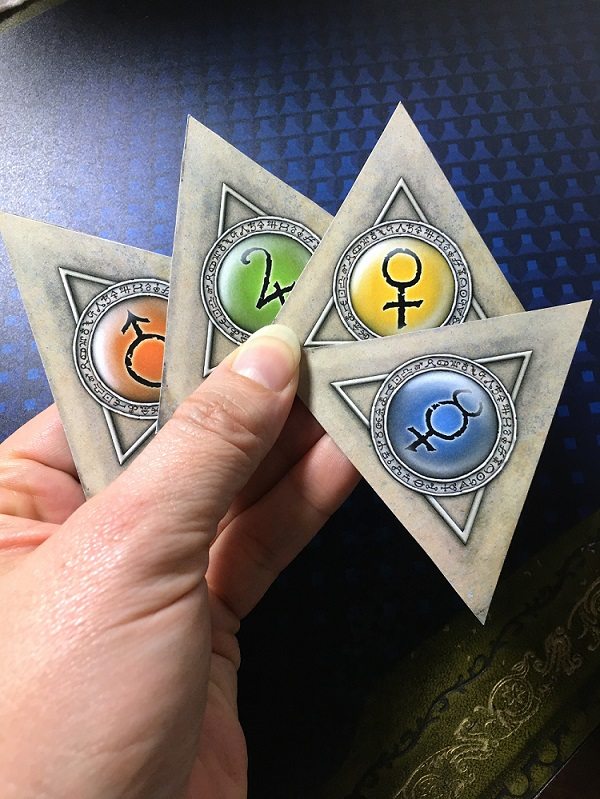
Any game with the opening line “our previous alchemist blew up; applications now open” is already off to a good start. Kwintessens is a fast-paced, strategic tabletop game based on medieval ideas of alchemy and the four elements: Earth, Fire, Wind, and Water. Harness the elements of alchemy before your three opponents and gain all the points and power!! It’s like this game was designed specifically with my Evil Genius Family in mind!
Overview
Kwintessens is a strategic card game for 2 to 4 players, ages 10 and up. Sidenote: 8-year-old Nefarious has already picked up on some of the rules a lot faster than I did, so the age estimates are fairly flexible. Gameplay takes about 30 minutes to complete. The cards are a unique feature: your playing cards are triangular, perfect for the theme and format of play, but a challenge when shuffling.
Kwintessens is the second game created by Cradle of Games, a Dutch two-person team with a love for history. Bert Menting is “The Mechanic,” an IT specialist with a knack for working out the structure and form of gameplay. Sanders ten Napel is “The Artist,” with an eye for design and historical accuracy. Kwintessens is their second Kickstarter campaign, the first being the successfully funded Puerto Diablo, a fast-paced card game with a pirate theme.
New to Kickstarter? You really should check out our crowdfunding primer before diving into this glorious rabbit-hole. It’s totally worth it for the pre-emptor tips and the experience of Kickstarter.
Components
I received a prototype of the game for review purposes. That means I have a sneak peek at the stunning artwork and I will update this post later with the finished product. Certain aspects such as the quality of the cardboard and the exact patterns for each element may change between now and delivery in December 2017. Though, Sanders seems pretty committed to the overall style of the artwork and production. Each game comes with:
- Gameboard/Elemental Compass–used for “announcing” which element you will be playing in the next move, a progressive restriction on your play since your counter can only move one step around the compass during each round
- Aleph card–It’s The First, and reminds everyone who is going first each round
- White Starting Quintessence Card–this is the centre wildcard for starting the game
- 4 Dragon Quintessence cards (each with an individual dragon to represent one of the four elements)– these are wildcards you may collect as a reward for being the first to distill each of the elements
- 4 Markers, one for each player to mark their distilled elements and position on the elemental compass
- 20 Triangular element cards for each of the 4 players, containing 5 cards of each element numbered 1 to 5
In the prototype, the cards are printed on thin cardboard. For the final product, the designers are planning to print on thick durable cardboard with rounded corners. A much nicer touch to ensure the longevity of the game without enticing the kids to throw ninja stars.
The triangle shape is… different to shuffle. I am extraordinarily uncoordinated and had great difficulty the first couple of times playing. You’ll get the hang of it. And to be totally honest, it is a small issue since the cards are very easy to hold and play with. You will want to play this game often enough to gain the practice.
The artwork is beautiful and draws you into this medieval world of science and magic. Sanders has included lovely muted colors, with that strong feel of European art of the Middle Ages. Reminds me of the art you see in Italian churches, especially Leon Battista Alberti.
The symbolism conveys the same feel, incorporating traditional symbols of alchemy in the elements and characters. Both EG Dad and I noted a strong similarity between the air element and water element. The designers have already been thinking a lot about this and are looking to include more yellow in the air element, once again bringing in more traditional features in their symbolism and color.
How To Play
“The kingdom’s foundations shook when, during his most spectacular final experiment, the court alchemist himself happened to explode… The King is now looking for a new alchemist. Whoever can present a pure element four times, will become the new court alchemist and be rewarded with a fiefdom one-fifth the size of the entire kingdom.”
Kwintessens
Sounds easy? Except you are playing against three other alchemist-wannabes.
Each player starts with all 20 cards in their chosen color (blue, green, red, or yellow), along with three of the four matching character tokens. The fourth marker is randomly placed on a starting element of their choice on the elemental compass, next to the playing area. On each corner of the compass is a triangular dragon quintessence card, sitting like gargoyles guarding the elements just waiting for you to completely stuff up your game (for me, they didn’t have to wait long). The white quintessence card goes in the middle of the playing area and the Aleph Card goes to the eldest player. Nice and neat.
To start, each player shuffles their deck (as best they can) and takes the top six cards. The remainder of their deck is then face down in front of them (closed deck). Now the game begins!
The game itself is strategic, with a bit of card counting. The numbers on your cards are used twice over: to determine who starts each round, and to play in ascending sequence when “distilling a pure element.”
The “Order of Play” is pretty straight-forward.
- At the beginning of each round, players must have 6 cards in their hands. You may swap as many cards as you have character tokens in front of you, always ensuring you start each round with six cards in hand. Swapping a card out is a great way of building up your element collection within each turn, making it easier to distill a pure element. Added bonus is the cards swapped out go to the bottom of the closed deck, meaning you will still be able to use them later. Very helpful.
- Starting with the player who has the aleph card, each player may move their character marker on the elemental compass 1 quadrant left or right. Whichever element quadrant you are on, that is the element card you must play in this round.
- Determine the order of play with a “blind bet.” All players choose a starting card and place it face-down in front of them. All players then reveal at the same time. Whoever has the lowest number on their card plays their card first for this round. If there is a tie, the player closest to the aleph card in a clockwise rotation will go first.
- You must place your starting card with one side touching an existing card. The white quintessence card is a “wild card,” to be used as any element you require to distill your first pure element. There are four other wild cards (the dragon quintessence cards), rewarded to each player who distills a purified element first (a dragon for each element).
- Once you place your starting card, you may play any number of cards, so long as they are the same element AND are in sequencing order (eg. 1, then 2, then 3). At the end of this step, the aleph card moves to the last player who played a card for this round, and the next round begins. This is where distilling your element comes in to play…
Distilling a Purified Element
To distill a pure element during your turn, you must place the fourth triangle to create one larger triangle of the same element. You can do this by either placing all four cards in your turn (in which case, I am very jealous of your card-drawing karma), or you can build your larger triangle using the cards placed by other players before you.
Each purified element may only contain one quintessence card (either the starting white or one of the dragons… I’m coming to that). Your pure element must also match the element you selected on the elemental compass marker. Once created, you can then place a character marker in the centre of the large triangle. The number on this element card will count towards your points at the end of the game, so you need to be smart about your placement.

As the first person to distill each element, you can claim one of the dragon quintessence cards as your reward—but only while stocks last! These cards are then used as wild cards for future rounds. To discourage the greed, you can only have one dragon quintessence card at any time—so, again, some strategy is required. The dragon quintessence card can never be the first card you play in your turn; it can never be used in the “blind bet.”
The creators have really thought about how to restrict too much power play, and I like it. Makes for some deeper thinking in how you play your cards. Way too many times, I found myself distilling a pure element only to realise I still hadn’t used my dragon quintessence card and subsequently WASTING the perfect opportunity to gain ANOTHER wild card. *groan* You can always tell a good game by the volume of play: the louder we are, the more emotionally invested we are in the game. This game had an ever-increasing volume, punctuated with “Aw man! I should have used my dragon!!” and “Oh c’mon!! I was going to go there!!”
Transmuting a Purified Element
Now here is a sweet twist on the game-plan: you can steal character markers from other players by transmuting their purified elements. Essentially, you are breaking up all their hard work, and replacing one of their element cards with a new element type of a higher number. They can always claim it back, but only after they distill another element. Until then, they run the risk of their marker counting towards your points at the end of the game. I thoroughly support this devious behaviour; it takes a bit of planning to pull off a transmutation. And when your opponent wails in frustration, the satisfaction is even sweeter.

End of Game
The game immediately stops when a player distills their fourth purified element, taking their character marker off the elemental compass and placing it on their large triangle. To the winner go the spoils and bragging rights.
However, if the game has continued to the point of running out of cards in your deck (remember, you have to replenish to six cards for each round), then the current round is played to completion. When finished, you start counting up the points: 10 points for each of your markers on a purified element, plus the number of the element card the marker is resting on, plus 1 point for every card in your hand and deck, plus 5 points for each marker you have stolen from another player. I especially like the idea of points for each card remaining in your deck and hand. It encourages players to use their cards wisely, and not just throw them around the play area.
The Verdict
This is definitely a hit in our family, and a game that can easily be pulled out and played regularly. It requires enough strategy to inspire the spawnlings to try and out-do me, however it has a little room for luck when drawing cards from your deck.
Initially, I found it reminiscent of Qwirkle, with the strategy and placement of tiles/cards. In that same manner, you need to take risks with your card placement, knowing that if you leave an incomplete triangle in play, the next player is highly likely to steal it from you. It also means you have to really think about where you are placing your cards and keep track of which numbers you have already used.
Speaking of the cards, the triangles are a fascinating part of the game, and in a good way! They are essential to the character of the game; triangles are The Symbol of Alchemy and the elements (anyone who has seen The Fifth Element will know this). But it’s more than that. The shape of the triangle in the play area takes a little effort to adjust to. I can’t quite put my finger on it but having to look at the play area in triangles and not squares was… challenging. And I liked it. It made me stop and think about the placement, which made me feel more involved with the game. It never allows you to fall into a sense of comfortability or apathy. You have to pay attention.

Kwintessens ticks so many boxes for our family. It’s quick; it’s strategic; it’s active; it’s beautiful to look at; it’s the kind of game you can easily pull out and play without too much hassle in setting up. I am really eager to see what the designers offer in regards to final printing and a box for the whole set. Their previous Kickstarter project, Puerto Diablo, was successful and is also beautiful in its art and form.
The Kwintessen Kickstarter campaign launches Sunday, May 28 with delivery expected to be December 2017. Pledges can also include copies of their previous game, Puerto Diablo, along with a few stretch-goals including expansion tiles and possibility for a 5th player.
Head over to the Kickstarter campaign and pledge for your copy of Kwintessens. With an early bird price of 16 Euros (about USD$18), this is an absolute steal!



Dear Evil Genius Mom and family,
Thanks a lot for the nice review of Kwintessens! Your kind words concerning my artwork were especially nice to read with all these game-mechanic-guys surrounding me 😉
When I created this game in it’s first incarnation 19 years ago, I had no clue that it would find it’s way from Holland all the way to the other side of the world. (I didn’t actually work on it for 19 years, but asked Bert two years ago to spice it up a bit, which he did in brilliant way).
I’am very curious what the start of the KS-campaign tomorrow will bring…
Anyway: love the geek parents! Keep up with the great job you are doing.
Best regards,
Sander ten Napel (Cradle of Games)
Totally our pleasure, Sanders. We love checking out new Kickstarter projects, and this is definitely a game I am more than happy to support. Probably the safest introduction I could ever give the spawnlings to alchemy and medieval Europe (… yeah, my trebuchet project was a bad idea…)
Actually I worry a bit about the safety of alchemy as an introduction to medieval Europe. When your kids start experimenting in your kitchen to create a philosofers stone, be sure they do not get introduced to the stratosphere 🙂
The campaign isn’t sky rocketing as we speak but we’l do our best to send you the finished product as soon as we can…
(Kind of curious by the way about your plans to use obsolete machinery to launch your offspring)
Cheers, Sander